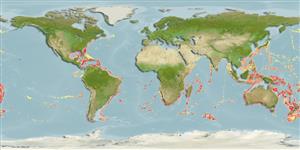>
Acropomatiformes (Oceanic basses) >
Epigonidae (Deepwater cardinalfishes)
Etymology: Epigonus: Greek, epi = over, in front + Greek, gonio = angle (Ref. 45335).
Environment: milieu / climate zone / depth range / distribution range
بوم شناسي
دريايي; لب شور موجوداتی که در اعماق زیر 200 متر زندگی و تغذیه می کنند; تغييرات عمق 550 - 1300 m (Ref. 31632). Deep-water
Indo-Pacific: Tanzania to Viet Nam (Ref. 31632), Indonesia (Ref. 26165) and western Australia. Western Atlantic: Florida, USA (Ref. 31632) to Suriname and French Guiana (Ref. 13608).
Size / Weight / سن
Maturity: Lm ? range ? - ? cm
Max length : 21.2 cm SL جنس نر / بدون خواص جنسي; (Ref. 26165)
No opercular spines. 8 spines on first dorsal fin. Pyloric caeca 7-8 (light organ present in one of the caeca). Premaxillary teeth elongated, thin, remain visible when mouth closed (Ref. 31632).
A mesobenthic-pelagic species living mainly above the bottom (Ref. 31632). Found on the continental slope (Ref. 7300).
Life cycle and mating behavior
بلوغ | تولید مثل | تخم ریزی | تخم ها | Fecundity | توزاد ( لارو)
Paxton, J.R., D.F. Hoese, G.R. Allen and J.E. Hanley, 1989. Pisces. Petromyzontidae to Carangidae. Zoological Catalogue of Australia, Vol. 7. Australian Government Publishing Service, Canberra, 665 p. (Ref. 7300)
وضعيت در فهرست قرمز IUCN (Ref. 130435: Version 2024-2)
خطر برای انسان ها
Harmless
استفاده انسانی
ابزارها
گزارش های ويژه
بارگيری XML
منابع اينترنتي
Estimates based on models
Preferred temperature (Ref.
123201): 2.9 - 9.6, mean 6.3 °C (based on 555 cells).
Phylogenetic diversity index (Ref.
82804): PD
50 = 0.5000 [Uniqueness, from 0.5 = low to 2.0 = high].
Bayesian length-weight: a=0.00646 (0.00275 - 0.01515), b=3.10 (2.89 - 3.31), in cm total length, based on LWR estimates for this (Sub)family-body shape (Ref.
93245).
Trophic level (Ref.
69278): 3.5 ±0.5 se; based on size and trophs of closest relatives
جهندگی (Ref.
120179): متوسط, كمينه زمان لازم براي دو برابر شدن جمعيت 4/1 – 4/4 سال (Preliminary K or Fecundity.).
Fishing Vulnerability (Ref.
59153): Low vulnerability (16 of 100).
